Dinosaur Jr.’s J Mascis is rock ’n’ roll’s loudest low talker. Onstage, the reserved frontman is overshadowed by his three full stacks, summoning up President Teddy Roosevelt’s quote: “speak softly and carry a big stick; you will go far.”
Fellow volume-dealing stalwarts Emmett Jefferson Murphy III (drums)—better known as “Murph”—and Lou Barlow (bass/vocals) helped J form the band in 1984 after their first group, Deep Wound, dissolved. Both left Dinosaur Jr., and then rejoined in 2005. This core group has released eight studio albums of dynamically rich rock that teeters between a runaway locomotive fueled on feedback and buzzing riffs, and hooky, melodic, pop-soaked nimble rhythms that carry more than they crush. While never reaching the mainstream stratosphere like some of their contemporaries (including Nirvana, who opened for Dino Jr. in 1991), this consummate power trio have remained popular in the American underground by continually selling out theaters, splashing into the Billboard 200 (climbing even higher in the Independent and Rock charts), and headlining alternative-music festivals. All along the way, their soft-spoken shredder has ascended as a guitar-hero among musical outcasts.
Before Dinosaur Jr.’s sold-out show at Nashville’s Brooklyn Bowl, Mascis reconnected with PG’s Chris Kies to talk Teles (yes, you read that right; he’s touring with more Telecasters than ever), including the development of his new signature T that’s based on his studio-perfect ’58 model. We also witness two firsts for J: a Phantom-Tele-Jazzmaster Frankenstein and a Floyd Rose-equipped guitar.
Brought to you by D’Addario XPND Pedalboard.
The Phantom of the Bowl
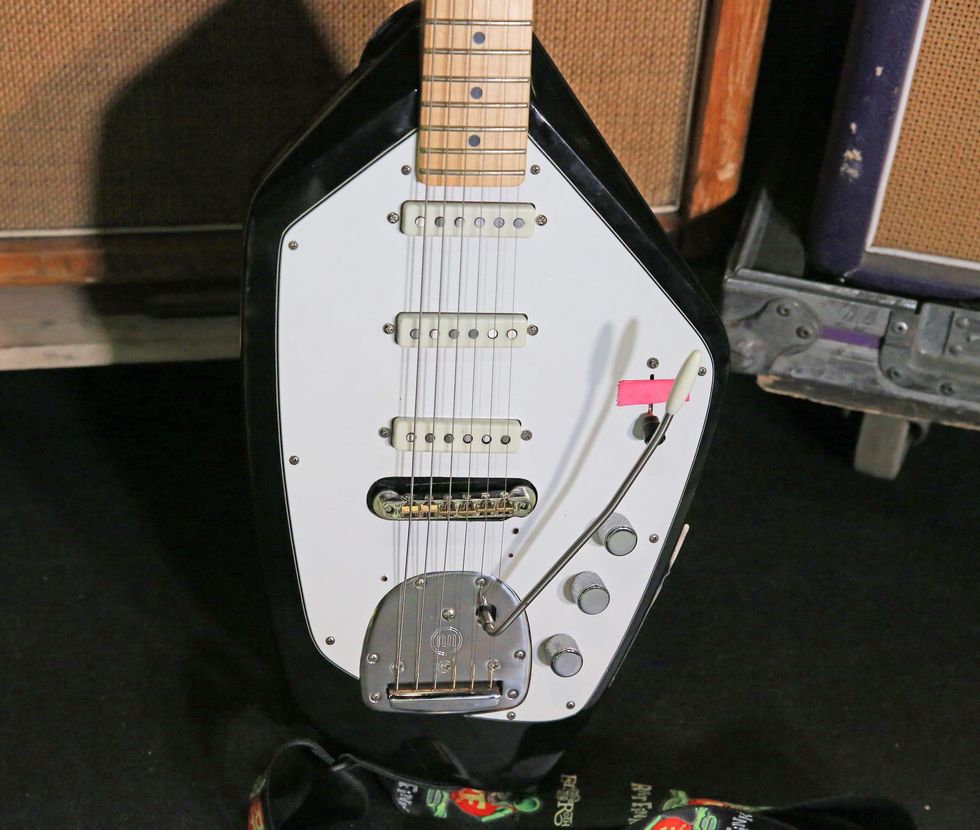
J Mascis has been linked to the Jazzmaster for decades. In 2021, he broke his offset mold, releasing a signature Fender Telecaster based on a beloved 1958 Tele that has long been his go-to instrument for tracking solos. But during our November 2021 chat at Nashville’s Brooklyn Bowl, Mascis mentioned that the ’60s Vox Phantom was his favorite silhouette. He could never get along with them onstage, so he’s cobbled together various parts and made his own dream machine. This guitar features a modern copy of a Phantom body, a Fender Deluxe Series Telecaster maple neck and fretboard (with jumbo frets), and a Mastery JM-style bridge.
The project was entrusted to and executed by Trevor Healy of Healy Guitars out of Easthampton, Massachusetts. Healy recounts: “My favorite thing about it was cutting around the Mastery bridge to fit snug inside the pickguard. There’s also a Seymour Duncan custom shop pickup under the bridge pickup cover, if I’m not mistaken.” Regarding the pickups we can see, Mascis tried several sets—including Fender Eric Johnson signature single-coils (middle and neck) matched with a Seymour Duncan Stra-Bro 90 (bridge)—before landing on a trio of Fender Noiseless single-coils. The guitar rides in open-G tuning and is used on “I Ain’t” from their new album Sweep It Into Space.
All of J’s guitars take Ernie Ball Regular Slinkys (.010–.046) and he shreds with Dunlop Tortex 1.14 mm picks.
Full-On Phantom
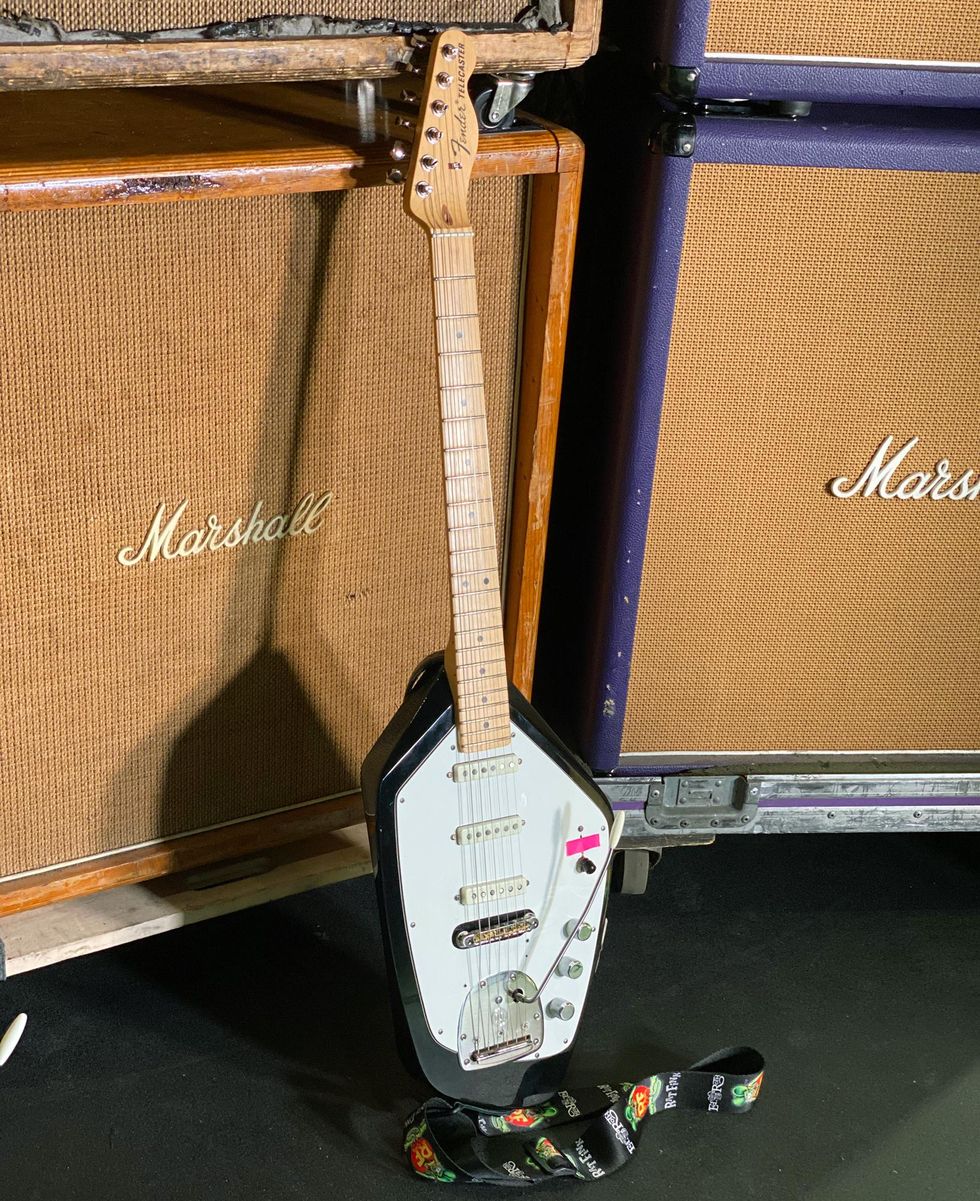
Here’s a head-to-toe shot of the marvelous mash-up.
Déjà Blue
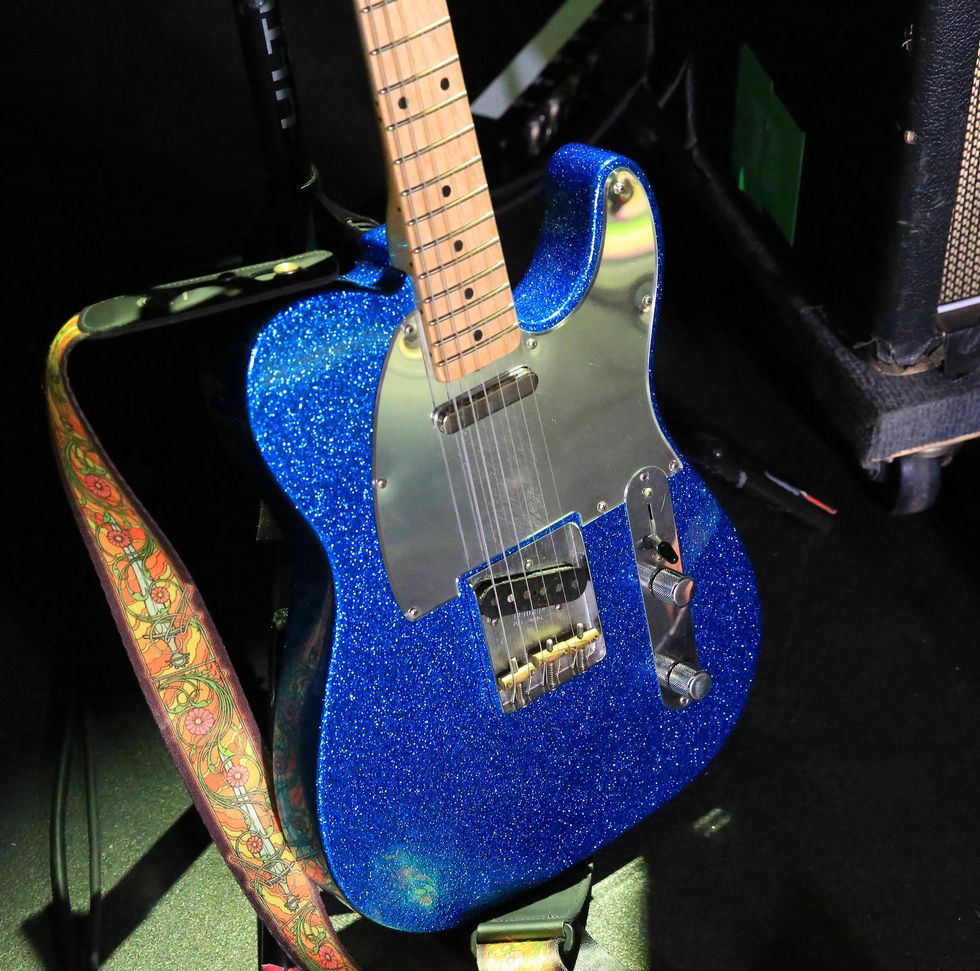
“I’ve started seeing it in guitar shops, and it’s weird because it’s like, ‘why is my guitar up on the wall?’,” jokes Mascis. “It’s not a guitar I designed, like with my signature Jazzmasters, so seeing a copy of a guitar I’ve had for decades is weird.” Mascis sort of fell into the Telecaster world by way of Fort Apache Studios owner Joe Harvard, who sold J the 1958 top-loading Tele that his new signature is based on.
Mascis played that ’58 while producing Buffalo Tom’s 1990 album Birdbrain at Fort Apache. Mascis let Harvard know that if he ever wanted to part ways with the Tele, he should call him first. Harvard swore he’d never break ties with the guitar, but only a few months later Mascis got the fateful call. In the Rundown, he mentions that since owning the ’58 it has appeared on almost every solo he’s recorded, because he tends to like what he plays on that Tele more than anything else he owns.
In our November 2021 cover story, J elaborated on what makes the blue-sparkle T so special: “On that Tele, I find my solos are more interesting. If I play the same solo on a Strat, it just sounds like a Strat to me. It’s slightly more boring somehow? I don’t know where my brain or fingers go or why that happens, but I usually find that if I play solos on different guitars for the same song, the stuff I play on that Tele is always more interesting. The top-loader was the first Tele I really bonded with, and it was about the feel. When I pick up Teles with string-through-body bridges, the strings are a little harder to bend. People say the top-loaders don’t have as much sustain, but I never thought of a Tele as a sustain guitar anyway, and when you hit a Big Muff, every guitar has sustain. So that argument doesn't really work for me.”
Notable ingredients for the production model include an alder body covered with a dashing bottle-rocket blue-flake finish (offset with a mirrored pickguard), a custom J Mascis C-profile maple neck that’s paired with a maple fretboard pocketing 21 jumbo frets, and J Mascis Custom ’58 Tele Single-Coil pickups. However, in the signature guitar he showed us, he swapped out the stock Fender pickups for a Seymour Duncan BG1400 Lead Stack Telecaster (bridge) and McNelly A2 or A5 T-style (neck). (The neck and hardware feature Fender’s “road-worn” treatment, too.) So far, he’s been using it on “Feel the Pain” and “Start Choppin’.”
Sparkle Spank
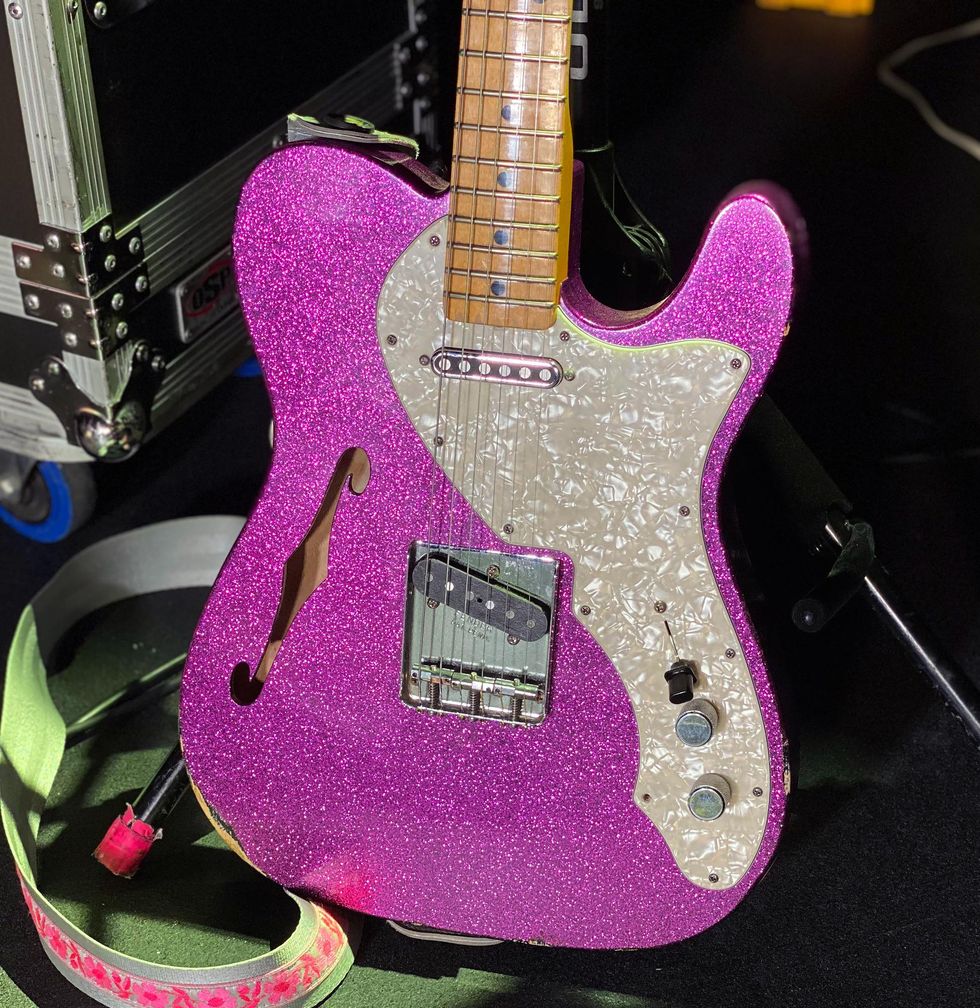
Prior to getting his signature Tele, this Fender Custom Shop Deluxe Telecaster Thinline was his favorite live T. The purple-sparkle axe features many of J’s go-to specs, like jumbo frets on a worn-down, C-profile maple neck and a top-loader bridge. (Although Fender delivered the guitar with a string-through setup, forgetting his request for a top-loading bridge, J quickly swapped one onto it.) As of filming, it had a Seymour Duncan BG1400 Lead Stack Telecaster (bridge) and TV Jones Starwood (neck).
JM Thinline for J
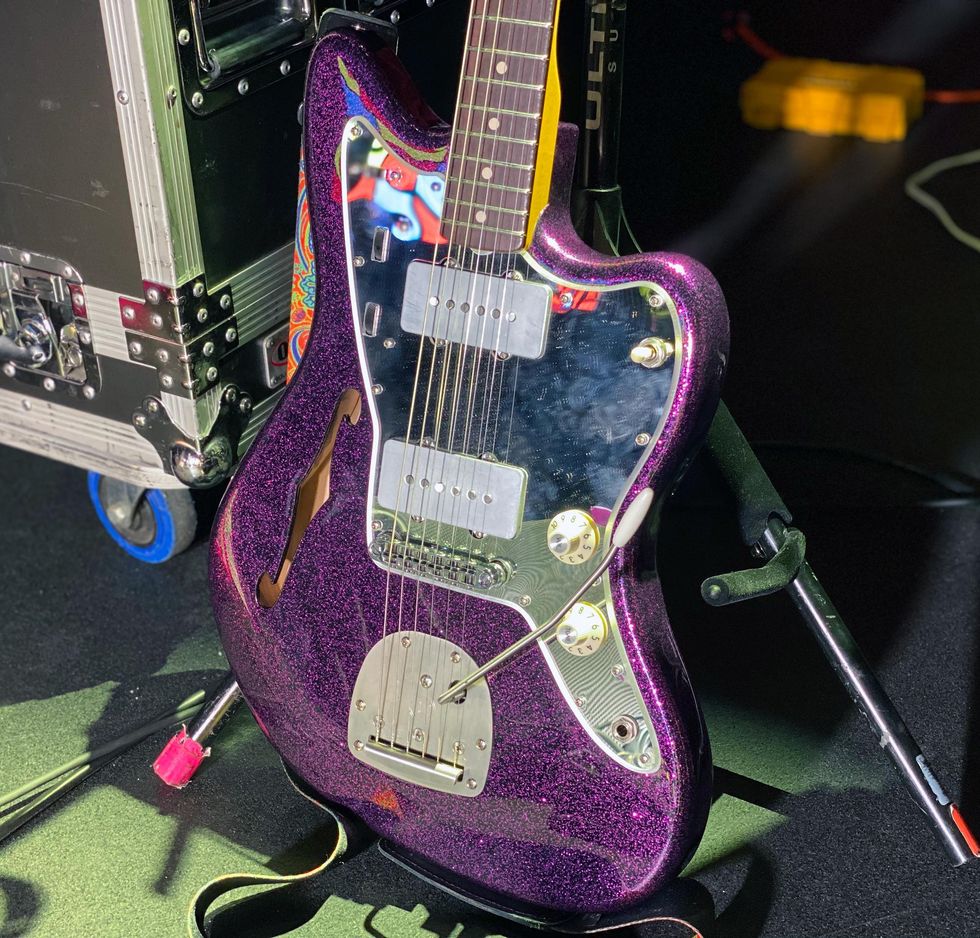
To match his Custom Shop Tele Thinline, Mascis requested a Jazzmaster Thinline semi-hollow in the hopes it’d be a lightweight option for extended practice jams, but the finished product came out heavier than J imagined. The Custom Shop JM-style pickups were spray painted by his tech.
A St. Vincent Jazzmaster?
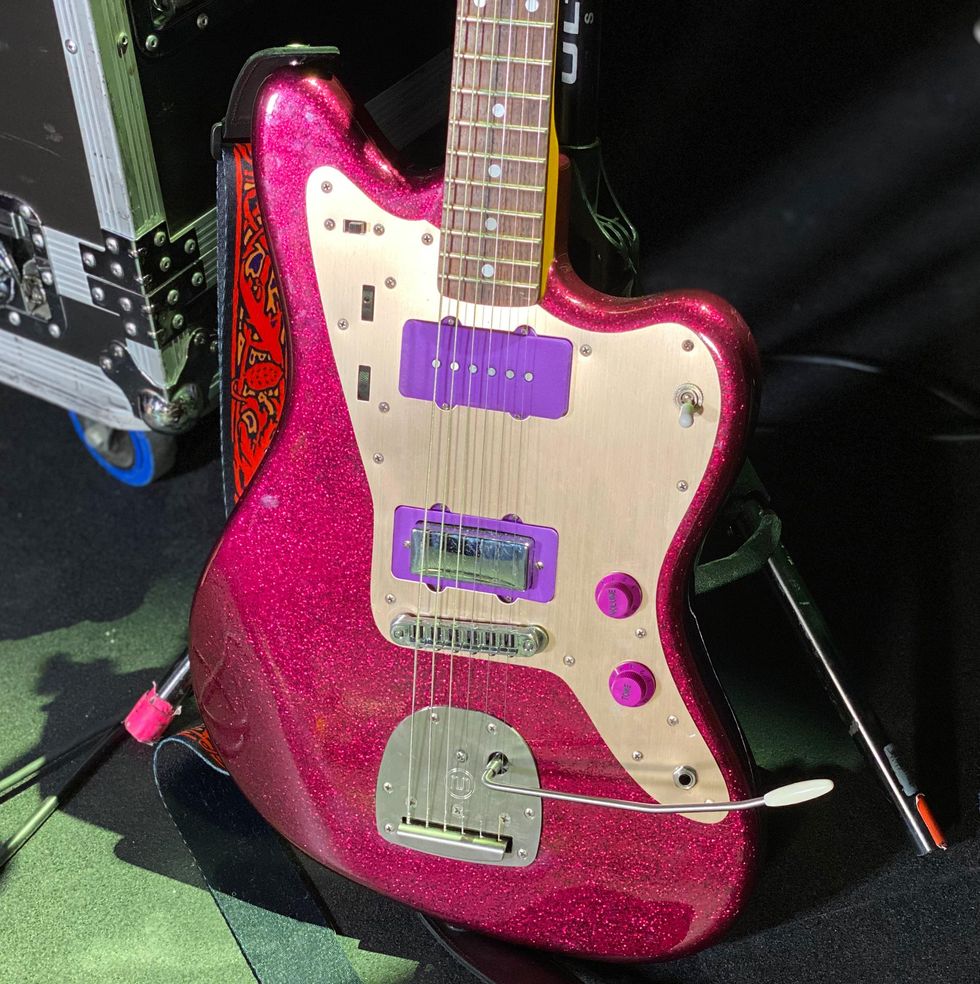
While recording Sweep It Into Space, J experimented with different sounds and tunings. One pairing that yielded a raucous result was using an Ernie Ball Music Man St. Vincent guitar in C#-tuning, which delivered the gnarly “I Met the Stones.” The foundation of the beefy track is the St. Vincent’s DiMarzio mini humbuckers into a Fender tweed. J shared this with PG in November 2021: “It [EBMM St. Vincent] seemed to play in tune well at that pitch. A lot of those rhythm parts are on that guitar through a tweed Fender Bandmaster. I think the sound on that song is mostly from the amp and the mini-humbuckers in that guitar.” So, his road-take on that instrument is a Jazzmaster with the neck pickup disconnected, blasting through the same DiMarzio bridge mini-humbucker that’s in the St. Vincent.
Tuxedo Tele
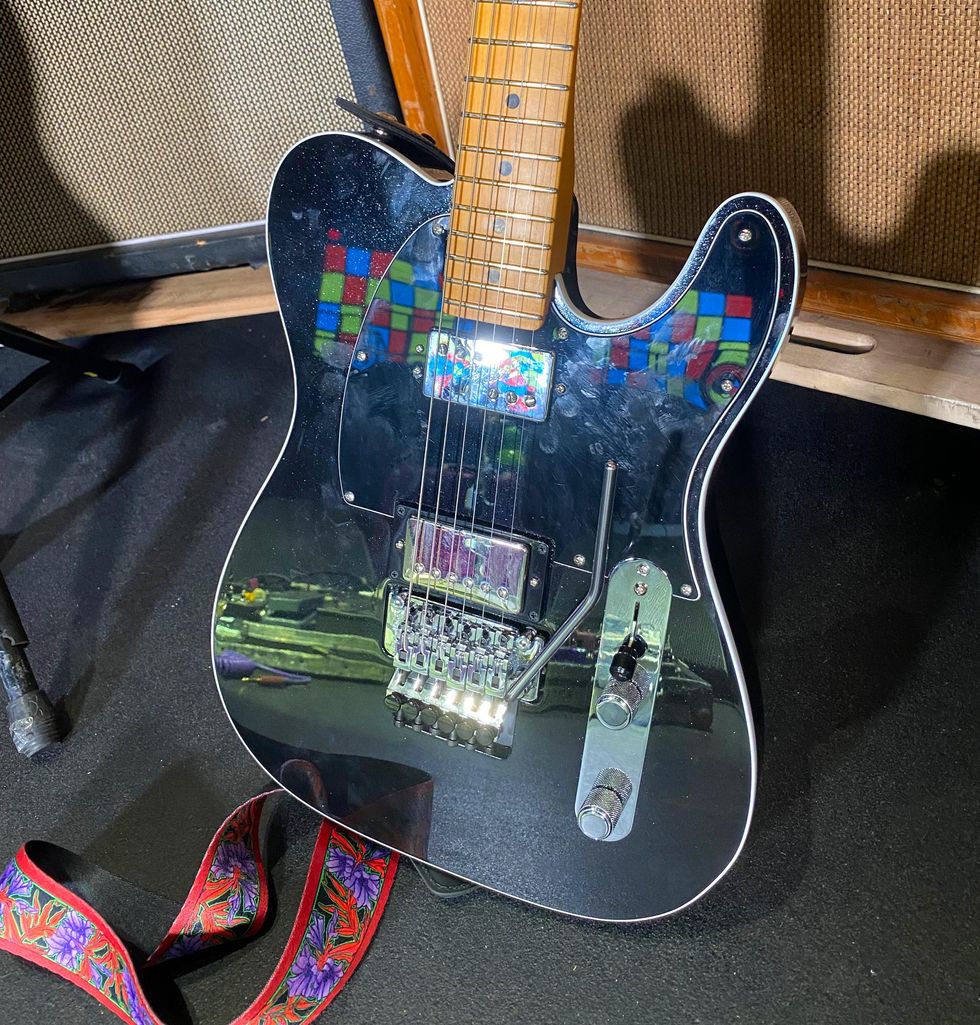
“I asked Fender if they had any guitars that would stay in tune in C#, and they sent this to me,” says Mascis. The Fender American Ultra Luxe Telecaster Floyd Rose HH is J’s first 6-string with a Floyd Rose trem and, noted in the Rundown, he eyed “Mountain Man” (from 1985’s Dinosaur) for its maiden voyage.
The snazzy Telecaster is constructed with an alder body, Fender’s augmented-D-shaped maple neck, a maple fretboard and 22 jumbo frets, Ultra Double Tap humbuckers (splitable via Fender’s S-1 switch), and a Floyd Rose Original Double-Locking 2-Point Tremolo bridge.
J For Jazzmaster
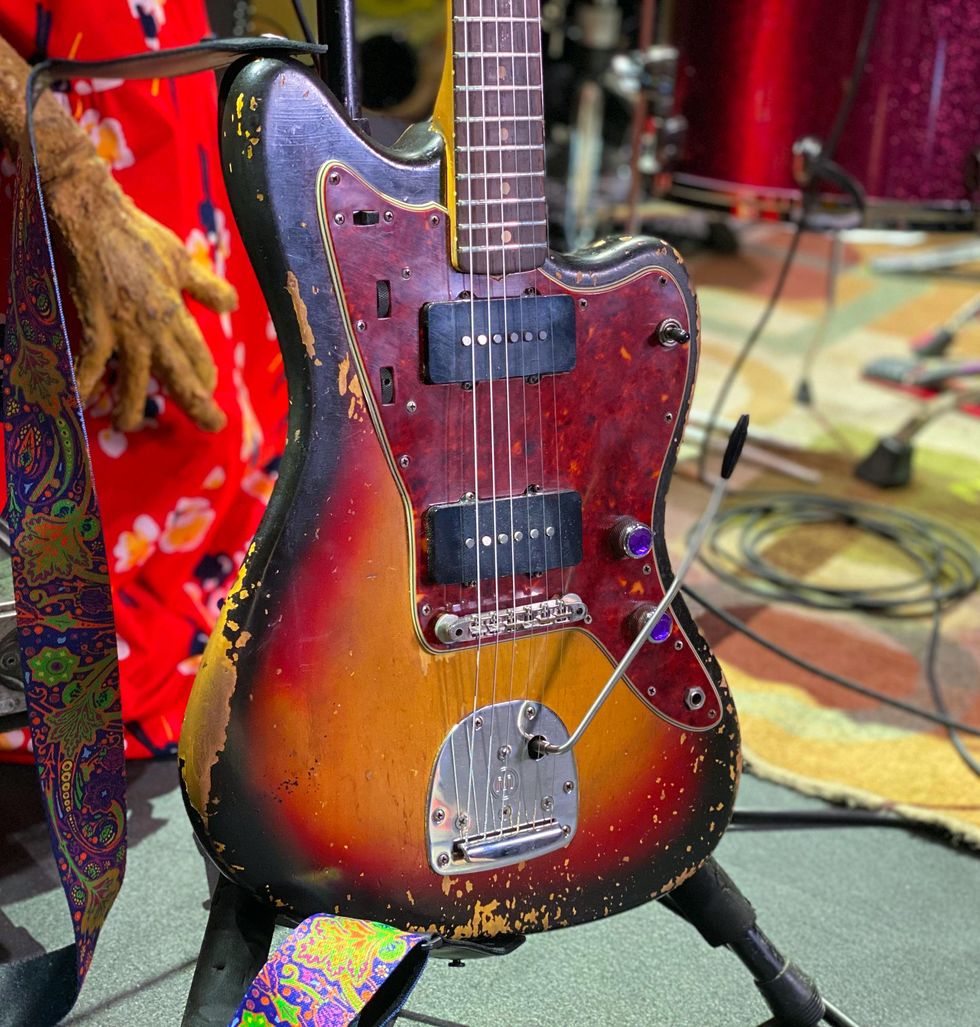
We’d be remised if we didn’t feature J’s longtime live No. 1—a sunburst ’63 Fender Jazzmaster with its original neck and pickups. He replaced the pickup covers and knobs, put in jumbo frets, subbed in a Tune-o-matic-style bridge, and since our 2017 episode, he upgraded the stock Fender vibrato to a Mastery.
Tone … Deaf
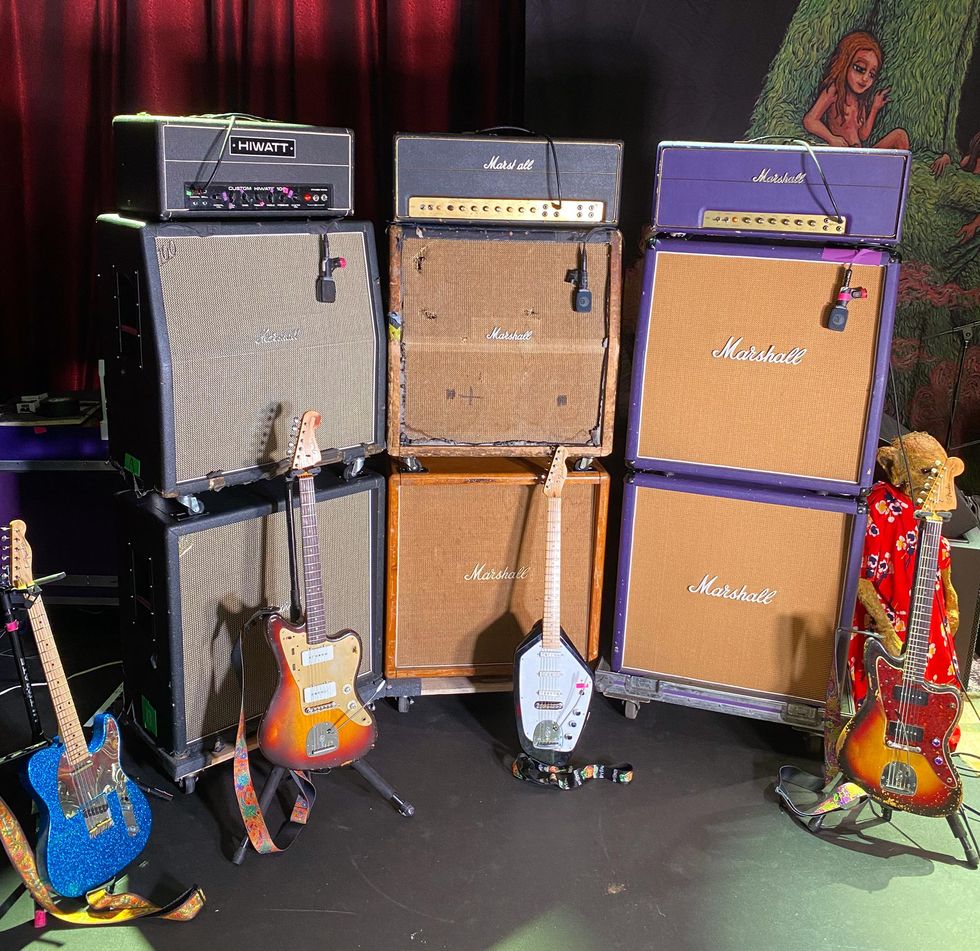
Anyone who has witnessed Dinosaur Jr. live recognizes these towers of tone. For years, Mascis has been flanked by the same three stacks and sidestage combo. Here we see three-fourths of J’s jumbo setup: two late-’60s Marshall Super Bass full-stacks and a vintage Hiwatt DR-103 head driving two Marshall 4x12s.
Close Ups
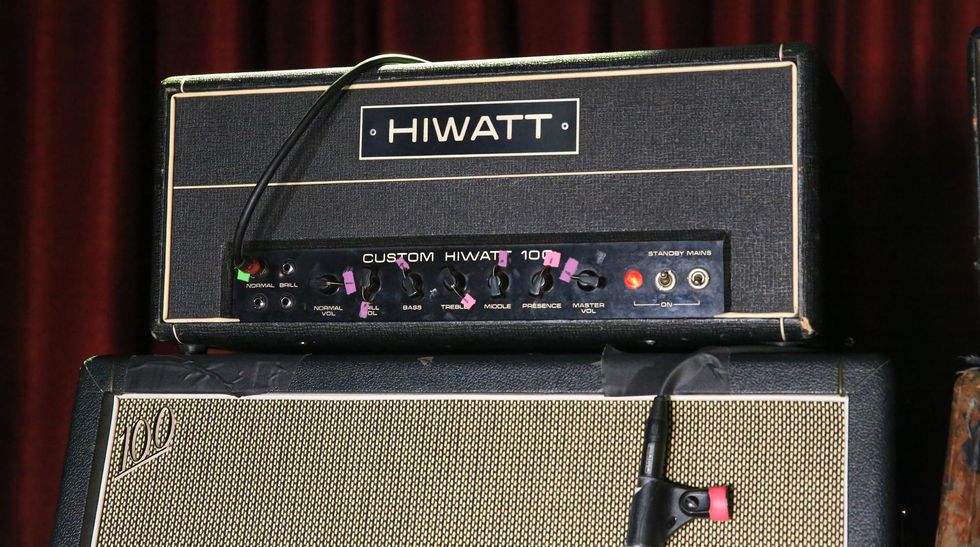
Vintage Hiwatt DR-103
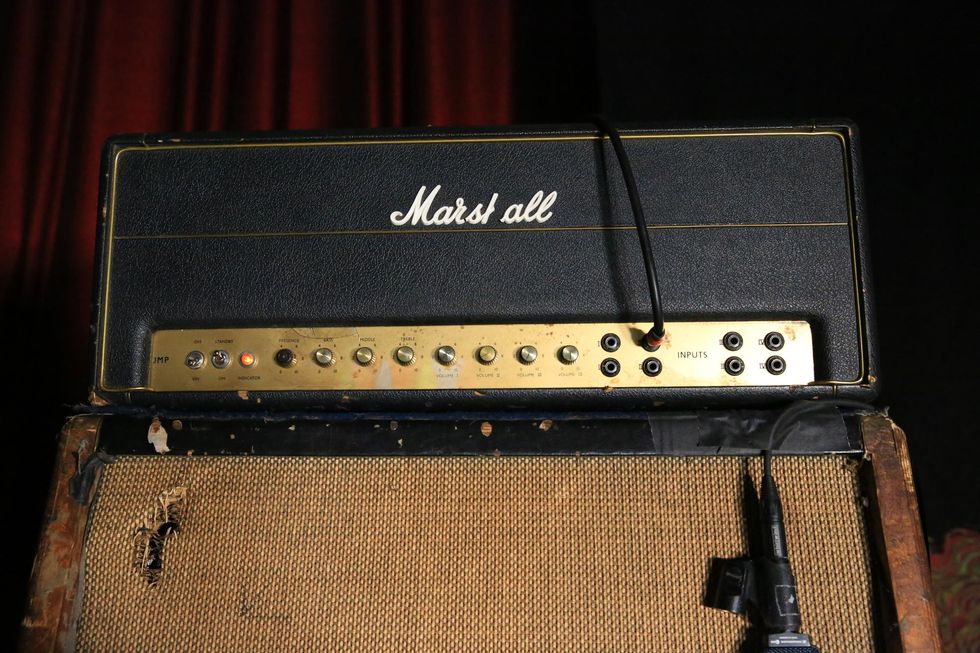
1960s Marshall Super Bass
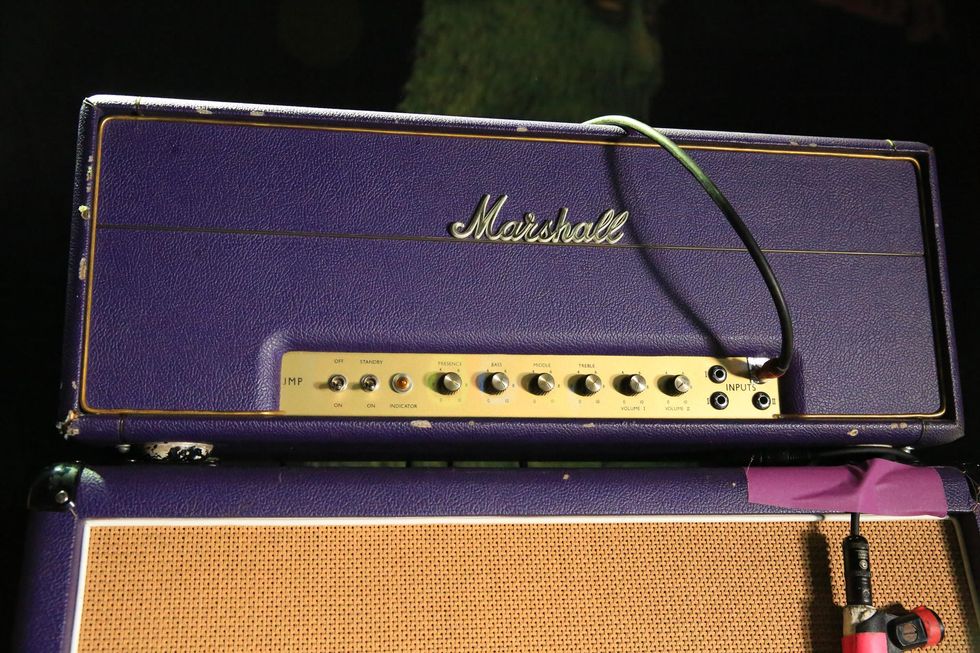
Another 1960s Marshall Super Bass
Fender Makes Four
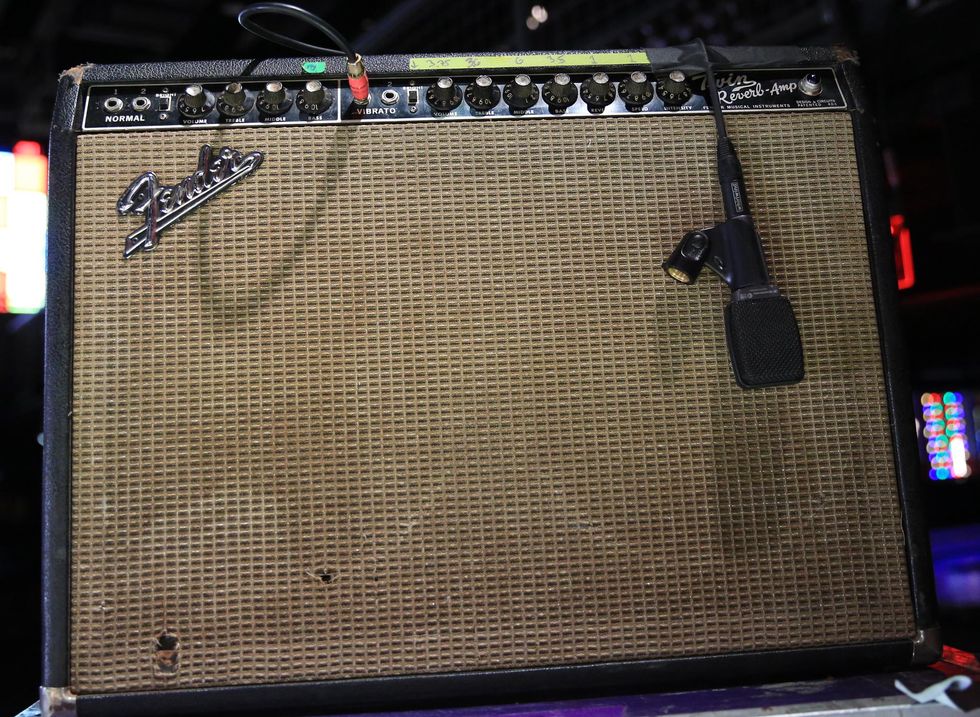
In the 2012 episode, Mascis was using a Victoria 80212 tweed Twin clone, but in 2017, and again in late 2021, he was using the same vintage Fender Twin Reverb.
More For Mascis
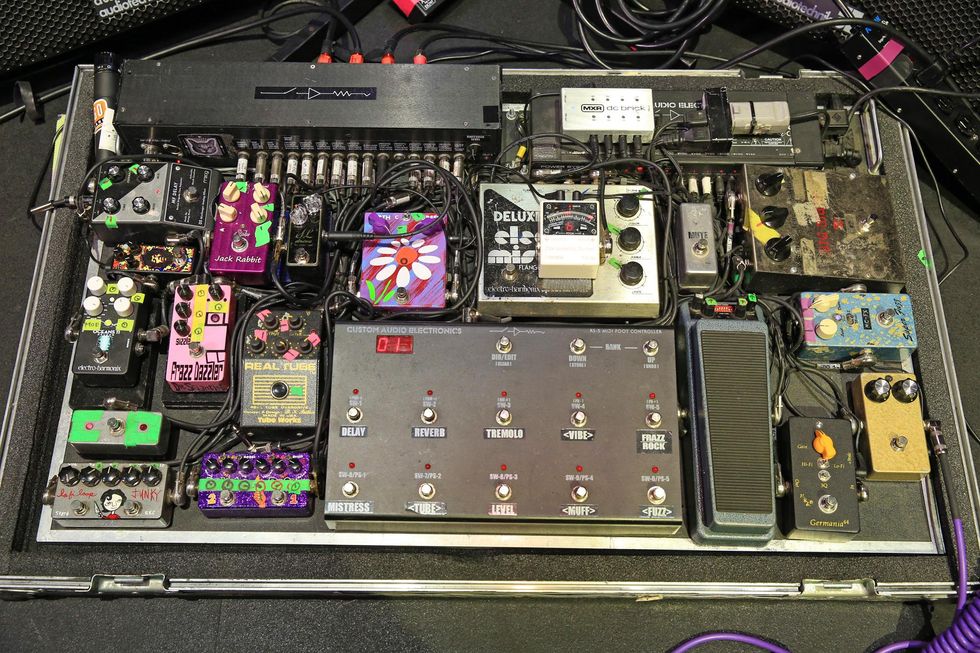
For at least 10-plus years, J Mascis has used a Bob Bradshaw-built Custom Audio Electronics switcher as his mission control. The standout stomps that were seen in the 2012 and 2017 editions include a Tone Bender MkI/Rangemaster-clone combo pedal made by Built to Spill’s Jim Roth (bottom right corner—in a third new enclosure since the 2012 and 2017 videos, each showing a different box), Mascis’ first Electro-Harmonix “Ram’s Head” Big Muff (top right), a vintage EHX Electric Mistress, an MC-FX clone of a Univox Super-Fuzz (lower right, blue box), a pair of ZVEX pedals—a Double Rock (two Box of Rock stomps in one) and a Lo-Fi Loop Junky (both bottom left), a Tube Works Real Tube Overdrive, a Moog MF Delay, and a Boss TU-3S Tuner. The new pedals not featured in the last two videos are a Homebrew Electronics Germania 44 treble booster (lower right), a JAM Pedals RetroVibe MkII, an Xotic SL Drive, a Suhr Jack Rabbit tremolo, a Dr. Scientist Frazz Dazzler fuzz, an EHX Oceans 11, and a (Dunlop) Jimi Hendrix ’69 Psych Series Uni-Vibe chorus/vibrato. Everything receives juice from either an MXR MC403 Power System or an MXR M237 DC Brick.
![Rig Rundown: Dinosaur Jr.'s J Mascis [2022]](https://www.premierguitar.com/media-library/rig-rundown-dinosaur-jr-s-j-mascis-2022.jpg?id=28736169&width=1200&height=675)

![Rig Rundown: AFI [2025]](https://www.premierguitar.com/media-library/youtube.jpg?id=62064741&width=1245&height=700&quality=70&coordinates=0%2C0%2C0%2C0)


![Devon Eisenbarger [Katy Perry] Rig Rundown](https://www.premierguitar.com/media-library/youtube.jpg?id=61774583&width=1245&height=700&quality=70&coordinates=0%2C0%2C0%2C0)























































